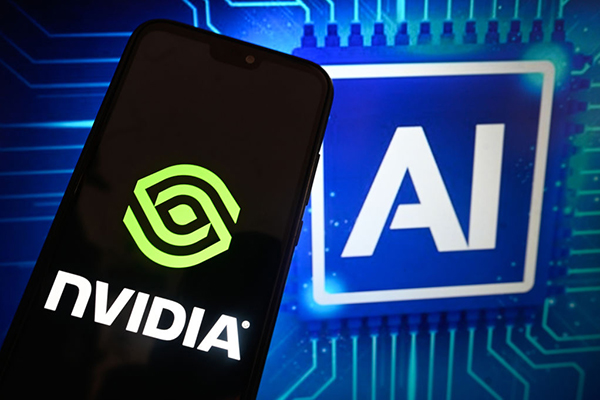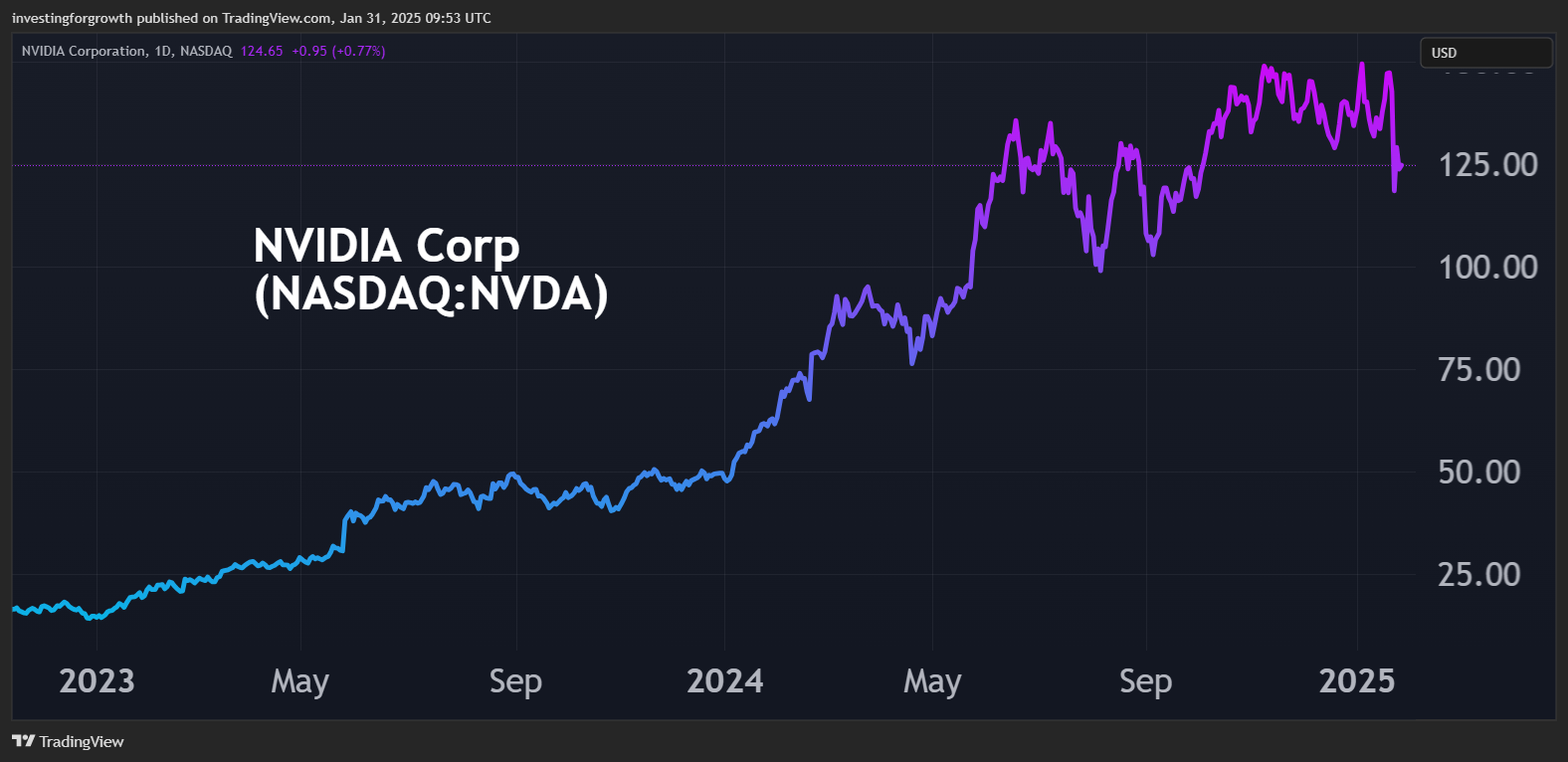Stockwatch: should you buy the drop in Nvidia?
After America’s tech sector was dealt a shock by advances in Chinese AI, analyst Edmond Jackson discusses the implications and whether it’s time to load up on this market leader.
31st January 2025 11:05

Has this week’s disruption of artificial intelligence (AI) by Chinese innovator DeepSeek struck at the very foundations of NVIDIA Corp (NASDAQ:NVDA), US tech valuations, and even the wider US economy? Or more positively, is it a reminder of how the inherent vigour of technology is apt to deal surprises and cut costs, benefiting vastly more businesses and consumers?
Both could have aspects of truth, explaining why this is a hugely significant development. But where does it leave Nvidia?
As yet, its medium-term chart barely reflects last Monday’s 17% plunge as earth-shuddering. There was sharp volatility last July and August, and this latest drop – despite being the biggest-ever daily loss of any share ever – essentially takes it back to its 200-day moving average.
- Invest with ii: Buy US Stocks from UK | Most-traded US Stocks | Cashback Offers

Source: TradingView. Past performance is not a guide to future performance.
On Tuesday, retail investors reportedly piled $1 billion into the shares, triggering a 6% rebound. However, Nvidia lost 4% on Wednesday and mid-yesterday was down another 5% to $118 before closing at around $125. I suspect some of that recovery was helped by yesterday’s weaker-than-expected data for the US economy, raising hopes for interest rate cuts which tend to benefit growth stocks. Wednesday’s drop similarly coincided with the Federal Reserve saying it would keep rates unchanged versus US inflation stubborn around 3%, and not re-iterating December’s message about “progress” towards the 2% goal.
- Why it’s not over for Nvidia or these mega-cap tech stocks
- Sign up to our free newsletter for investment ideas, latest news and award-winning analysis
Macro aside, and even though I am a sceptic on charting, I believe the sheer uncertainty with predicting how AI will evolve means investor perception is likely to default to whether this 200-day moving average level now holds. It is meant to be a key support level, hence liable to trigger further buying if affirmed, or vice versa.
Classic risks recently with an overcrowded trade
While I initially drew attention to Nvidia as a “buy” in June 2023 as it tested $40 (before a 10-for-one stock split) I subsequently moderated to “hold”, and around highs of $152 last November, if anything I was more concerned of being over-cautious. Despite my noting Rain AI’s processors allegedly surpassing Nvidia’s for energy efficiency and power, I said: “There remains a case simply to lock in for the ride”. While that could still be true, it underlines how mentally hard it is to detach from a highly successful tech share, simply on the basis that inevitably something better will appear.
I had, of course, made repeated comparisons with ARM Holdings ADR (NASDAQ:ARM), which was terrifically volatile when UK-listed, but despite a period of private ownership has progressed over some 30 years to be valued at $161 billion (£130 billion). I would not dismiss that benchmark amid current concerns towards Nvidia.
Key disruptive aspects of China’s DeepSeek are that it is deploying an AI reasoning model at (claimed) much lower power needs, after an alleged £5.6 million development cost far lower than for major US AI developers. It also rather pulls the rug from President Trump’s inauguration speech that declared a $500 billion investment programme in AI.
Genuine substance versus ‘shock and awe’
Yet even DeepSeek has conceded that its cost was just for one training run, not overall R&D to develop the model, although it was still lower than the amounts spent by major US AI developers. Mature Nvidia chips used, which had been stockpiled by DeepSeek’s founder some three years ago and are less advanced than current ones which cannot be exported to China.
As an amusing twist of US/China trade wars, one US tech entrepreneur described the $5.6 million number as “bogus”, and was aimed to slow investment in US AI and aid short positions taken out in the likes of Nvidia by a hedge fund also run by DeepSeek’s founder.
- Nvidia’s CEO sees Physical AI booming: here’s one of its big opportunities
- Where the pros are investing beyond the Magnificent Seven
Stepping back from the noise of a “shock and awe” attack, it remains possible that AI develops multiple paths along its transformative way. China is typically accused of copycat-style advances rather than true origination, which appears to hold here when employing Nvidia technology. Yet the evolution of its smartphone industry shows how, after initially copying the style of premium iPhones, China has evolved budget phones to attract users, then leveraged flagship Android’s that nowadays compete head-on with Apple Inc (NASDAQ:AAPL) and Samsung Electronics.
In this respect, DeepSeek’s efficiency leap is impressive, underlining China’s ability to harness the existing US technology for its own advances, leaving an open question as to how long before it might be creating than exploiting the hardware. That said, China’s flagship 2025 smartphones chiefly run the latest Snapdragon chips by US multinational Qualcomm Inc (NASDAQ:QCOM).
While it raises long-term questions about Asia/US competitive advantage of emerging technology, surely this aspect of major cost reduction for deploying AI is of huge wider benefit. It lays down a gauntlet to Silicon Valley to respond to DeepSeek’s better efficiency, and instead of AI soaking up huge budgets, there is potential for a vastly greater range of organisations to employ it.
I therefore see potentially greater overall “reward” from this week’s news, rather than a risk that it undermines US tech stock ratings and profits.
It is also a timely broad sweep at President Trump’s naive hopes to “make America great again” via an isolationist economy supported by tariffs – which would end up hurting everyone.
Nvidia may be on a very attractive PEG ratio
Mind, the time frame is suitably cute and a risk the consensus of analysts is prone to be trend-following after a boom period for Nvidia. But at near $125 currently, its price/earnings-to-growth (PEG) ratio may only be 0.56 when value is strictly seen below 1.0 and ARM is on more like 1.5.
Consensus targets Nvidia 2025 earnings per share of $3.0 and $4.5 in 2026, hence a forward PE of 42 falling below 28, relative to 50% earnings growth if achieved. It is a highly convenient time frame, but dividing the PE ratio by the underlying growth rate derives a super-attractive PEG ratio – assuming China is not poised to gnaw at US competitive advantage.
DeepSeek’s advance may also chiefly be a win for “open-source” AI models, given it has been made fully transparent, hence US/China competition is not the crux. Similarly, as Chinese smartphones still rely on US chips in a global technology sense everyone benefits.
- Insider: chiefs buy big exposure to 17% dividend yield
- High-flying Raspberry Pi optimistic about 2025
It does pose fresh risks over longer-term earnings estimates where US technology majors were assumed to have strong “moats” – especially the privately-held OpenAI research organisation in San Francisco. But as yet I tend to see this as classic for the way global technology advances, rather than pricking a bubble.
Predictions of a (tech) share crash have shot up this week, but valuations have a stronger basis than many flimsy dot.com structures in early 2000. I reiterate ARM as exemplifying how a hardware behemoth can navigate through. The sideways-volatile chart of Intel Corp (NASDAQ:INTC) over 30 years is a reminder how attention to industry positioning is essential.
A speculative ‘buy’ stance may be justified
In fundamental terms you would wait to see how forecasts on Nvidia might be affected, but no one truly knows anyway, hence traders taking their cue from the critical 200-day moving average level.
My sense on Nvidia has been that anyone fearing they were missing out on rallies could wait for inevitable drops to happen also, so unless US inflation and interest rates become problematic, routing growth stocks, this latest drop looks a buying opportunity. The 200-day moving average does need to hold.
Edmond Jackson is a freelance contributor and not a direct employee of interactive investor.
These articles are provided for information purposes only. Occasionally, an opinion about whether to buy or sell a specific investment may be provided by third parties. The content is not intended to be a personal recommendation to buy or sell any financial instrument or product, or to adopt any investment strategy as it is not provided based on an assessment of your investing knowledge and experience, your financial situation or your investment objectives. The value of your investments, and the income derived from them, may go down as well as up. You may not get back all the money that you invest. The investments referred to in this article may not be suitable for all investors, and if in doubt, an investor should seek advice from a qualified investment adviser.
Full performance can be found on the company or index summary page on the interactive investor website. Simply click on the company's or index name highlighted in the article.
Disclosure
We use a combination of fundamental and technical analysis in forming our view as to the valuation and prospects of an investment. Where relevant we have set out those particular matters we think are important in the above article, but further detail can be found here.
Please note that our article on this investment should not be considered to be a regular publication.
Details of all recommendations issued by ii during the previous 12-month period can be found here.
ii adheres to a strict code of conduct. Contributors may hold shares or have other interests in companies included in these portfolios, which could create a conflict of interests. Contributors intending to write about any financial instruments in which they have an interest are required to disclose such interest to ii and in the article itself. ii will at all times consider whether such interest impairs the objectivity of the recommendation.
In addition, individuals involved in the production of investment articles are subject to a personal account dealing restriction, which prevents them from placing a transaction in the specified instrument(s) for a period before and for five working days after such publication. This is to avoid personal interests conflicting with the interests of the recipients of those investment articles.
Editor's Picks